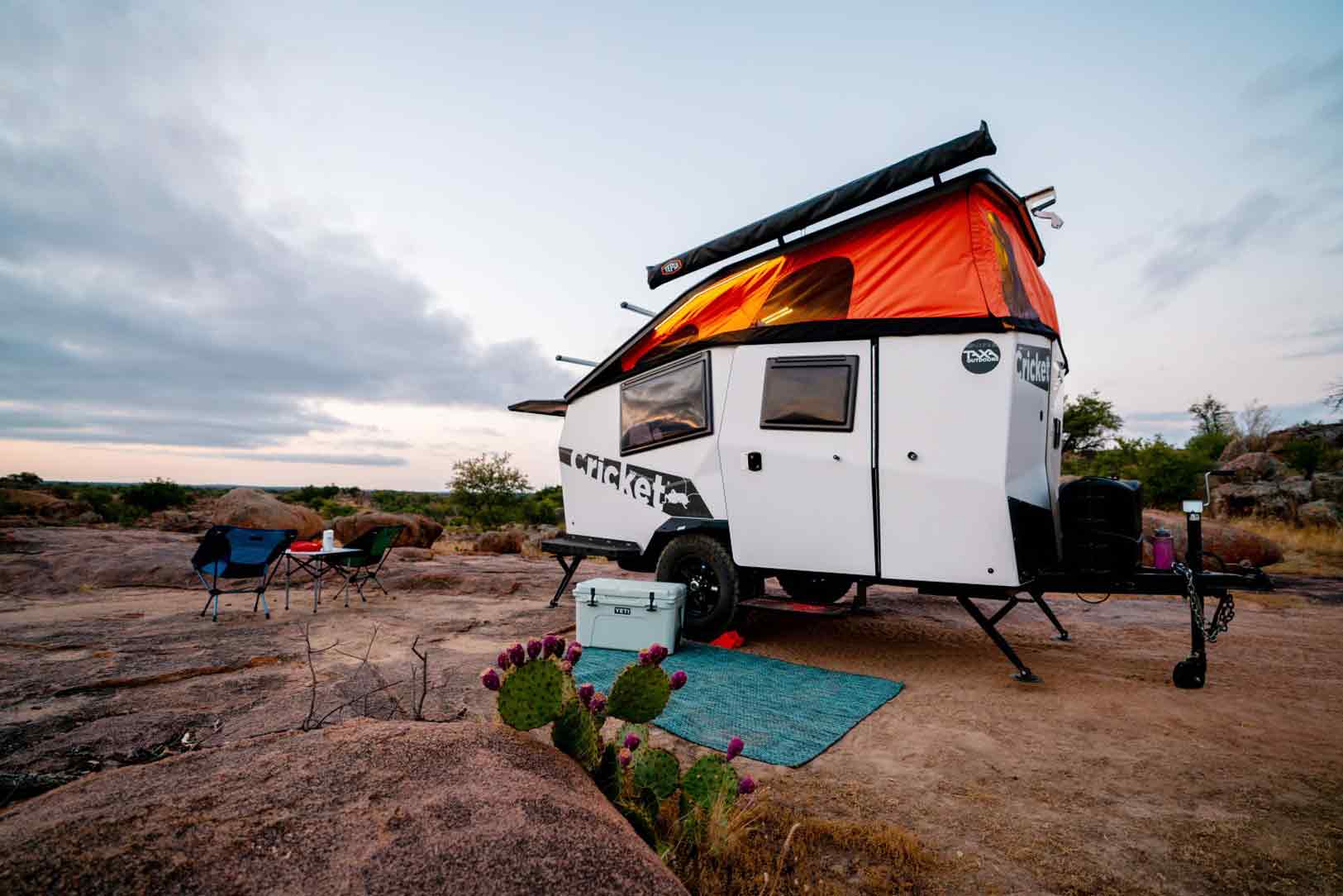Pop-up campers are undoubtedly the ideal choice for the single or couple campers who like to travel light to enjoy more flexibility or the occasional campers who don’t want to invest too much in a hard-sided travel trailer.
That said, one inherent disadvantage of this type of camper is the lack of insulation, coupled with the lack of heating and air conditioning. Fortunately, you can install a pop up camper air conditioner to keep you comfortable in varying weather conditions.
There are different types of pop up camper AC units, each with unique features, as well as other important considerations that buyers must keep in mind due to the characteristics of soft-sided pop-up campers.
To make your purchasing experience as painless as possible, Effortless RVing has compiled the 5 best pop up camper air conditioner models on the market, with something for every camping needs and budget.
You will also learn the various types of pop up camper AC, most important buying criteria, installation and maintenance guides, as well as clear cut answers to frequently asked questions.
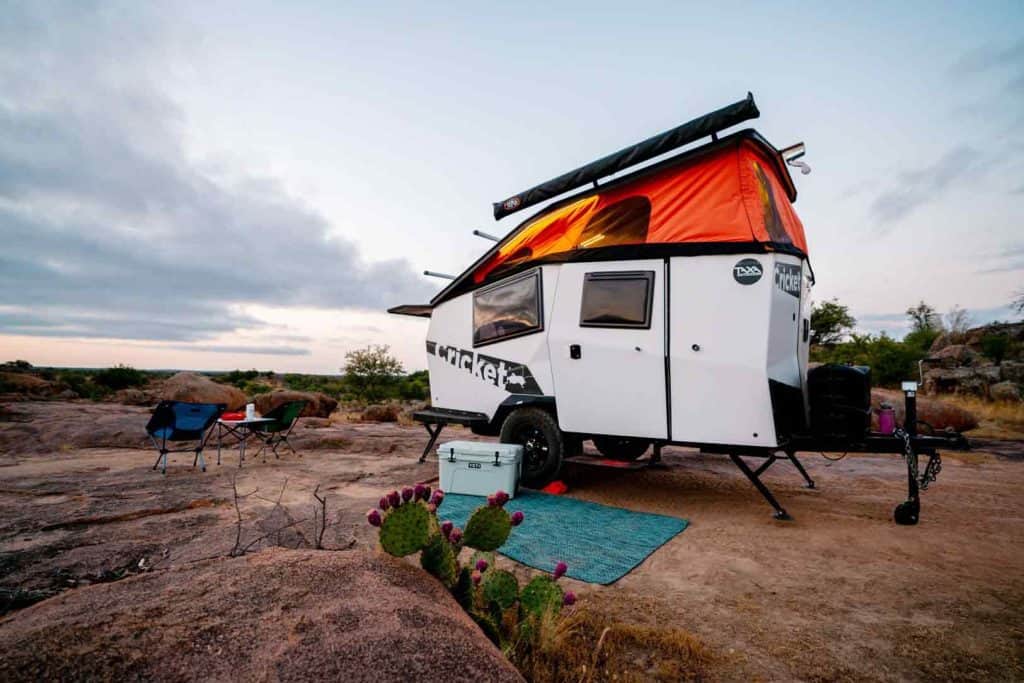
Contents
- Pop Up Camper Air Conditioner: The Basics
- Best Rooftop AC For Pop-Up Campers
- Best Window-Mounted AC For Pop-Up Campers
- Best Portable AC For Pop-Up Campers
- Choosing The Best Pop-Up Camper Air Conditioner: Buying Criteria
- How To Install A Pop-Up Camper Air Conditioner
- How to Maintain Your AC Unit?
- FAQs about Pop Up Camper AC Units
Pop Up Camper Air Conditioner: The Basics
Do you need AC for pop-up campers?
Pop-up campers are constructed from a non-insulated canvas material, thus they do not offer the same level of weather protection as their insulated, hard-sided counterparts. And most pop-up campers don’t come equipped with a heater or an RV air conditioning unit.
This means that if you only travel in very mild and cool climates, you might be able to camp comfortably in your pop-up camper without any heating or cooling units. Otherwise, if you do travel during the warmer months, not having a well insulated home on wheels and no air conditioner might get unbearable at times and you might lose sleep at night.
Traveling light should not mean that you must sacrifice such basic comforts like a livable interior temperature. After all, camping is not only about exploration, but enjoyment as well.
In addition to comfortable camping and pleasant sleep at night, adding a pop up camper air conditioner unit to your camping setup also opens up more traveling possibilities, since you can now travel during the warmest months and to hotter places without losing your peace of mind.
Types of pop-up camper AC units
There are three types of air conditioner for pop up camper, each with its unique pros and cons. Understanding the characteristics of each type would help you pick out the best type of AC for pop up camper depending on your budget and camping situations.
1. Rooftop-Mounted AC
If we’re only considering cooling capacity and which type is most desirable to have while traveling, then it’s no doubt a rooftop-mounted AC unit: they are the most powerful with the widest cooling area, conveniently equipped with a thermostat for easy control, quiet, doesn’t take up any space in the camper, and you won’t have to worry about removing them every time you’re about to hit the road again. So if you travel often and in very warm, humid weather, you’d want a rooftop-mounted AC unit.
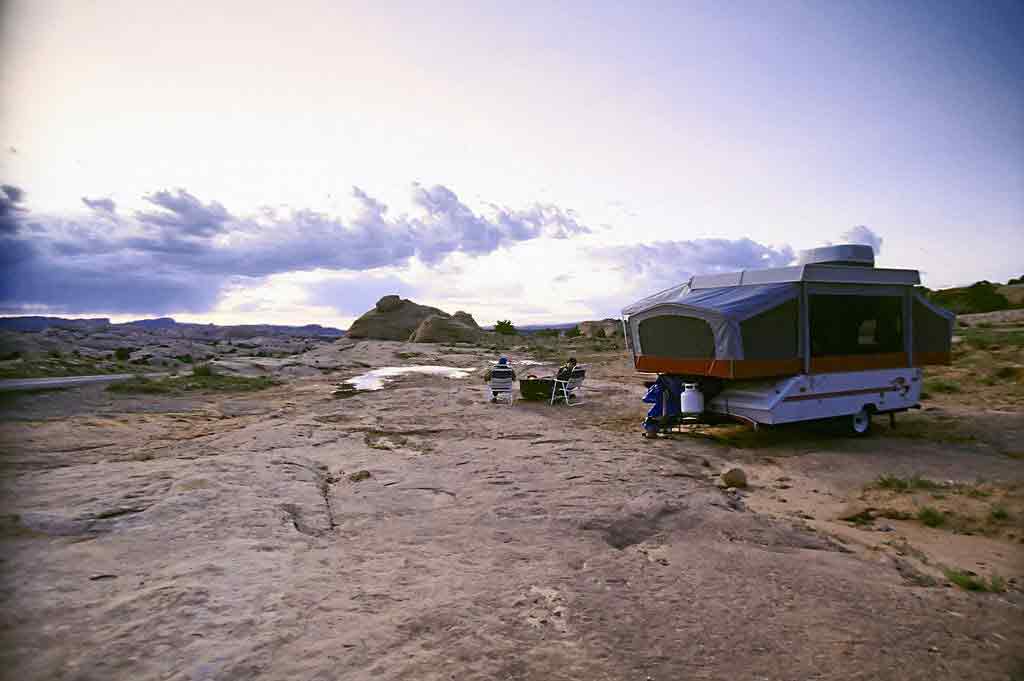
That said, if you’re a budget camper or if you don’t travel that much, a rooftop unit might not be the best investment for you. This type of air conditioner is the most expensive, plus the repair and maintenance costs are also high. They are the heaviest, thus are harder to install compared to the other types.
And this means that in some cases, they might require some form of additional roof support due to their weight, adding to the installation cost. Without proper roof support, the roof of your pop-up camper might sag over time, especially if you travel on rough terrains, which would cause the AC unit to bump against the roof.
In addition, while certain pop-up campers come ready with a hole on the rooftop for AC installation, sometimes you might need to make the hole yourself.
2. Window-Mounted AC
This type of AC is plugged into standard wall receptacles, with the compressor and fan protruding outside of your camper window. Although not as unobtrusive as a rooftop unit, window-mounted AC units also don’t take up valuable floor space inside your pop-up camper.
Compared to their rooftop counterparts, they are more affordable and also cheaper to maintain, but obviously can not offer the same cooling capacity. In exchange, they are not as heavy and difficult to install, and do not require additional structural support.
Their major drawback is that unlike the permanent installation of a rooftop unit, they are only temporarily installed and need to be removed and stored away every time you’re about to hit the road. Therefore, although they are affordable and can adapt well to different camping settings, this type is not suitable for campers who only stay in one place for a short period of time.
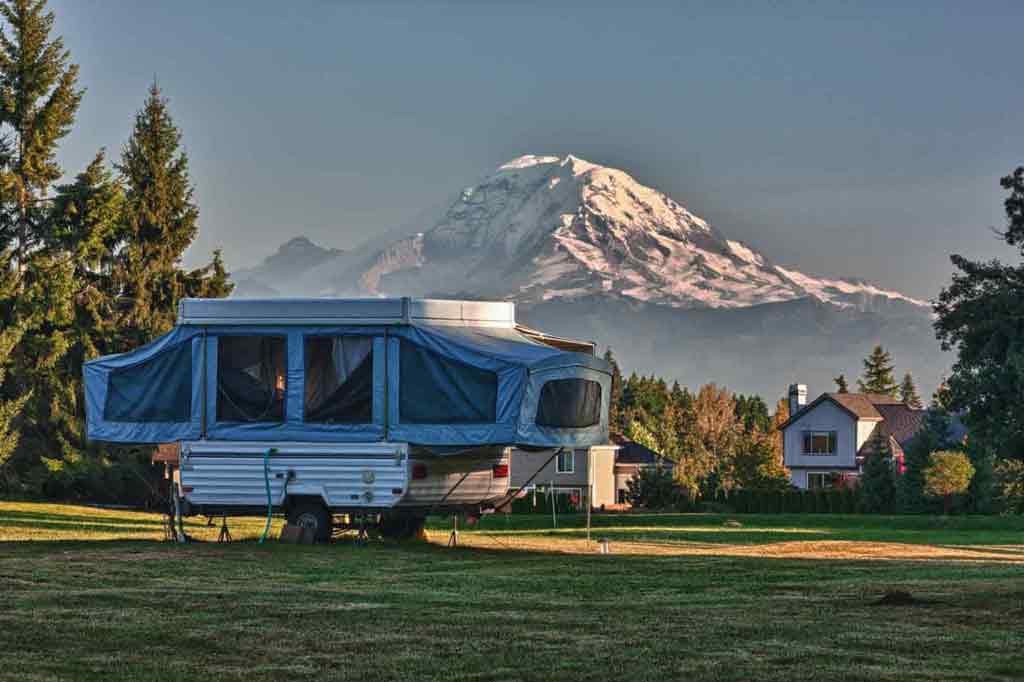
3. Portable AC
Portable AC for pop up camper is becoming increasingly popular thanks to their affordability and versatility. Although the earliest models of the type pale in comparison with window mounted units when it comes to cooling capacity, portable models these days boast quite comparable BTU ratings at about slightly lower prices, while not requiring installation.
Portable pop-up camper air conditioner units look like a portable dehumidifier used in the home, with wheels so that you can easily move it around in your camper. This means energy efficiency, since you can put it close to you to get instant relief from the heat without having to wait for it to cool down the whole interior. This also means that when you’re not camping, you can use your portable AC unit elsewhere, like in your home or the office.
While models of the type offer excellent value for money with regards to cooling capacity, remember that unlike the other types, they take up valuable floor space inside your limited pop-up camper. They are also the loudest, which might or might not be a deal breaker for you.
Pop Up Camper Air Conditioner Types: Summary
| Rooftop-mounted | Window-mounted | Portable | |
| Price range | Around $650 to $1,500 | Just below $200 to $500 | Around $250 to $450 |
| BTU rating | 13,500 to 15,000 BTU – Best cooling capacity, can cool a large area fast | 5,000 to 10,000 BTU | 5,000 BTUs to 13,000 BTUs, very few models rated for 15,000 BTUs |
| Installation | + Least straightforward to install + Heavy, might require roof support + Permanent installation, no need to remove when traveling | + Easier to install than rooftop models + Does not require additional weight support + Temporary installation, must remove before hitting the road | + No installation required + Often on wheels to be moved anywhere inside a camper |
| Pros | + Powerful and efficient + Quiet + Equipped with a thermostat + Doesn’t take up interior space | + Quiet + Easier to install and cheaper to maintain than rooftop units + Doesn’t take up interior space | + Portable and convenient + Energy efficient + The most affordable + Versatile: can be used in other spaces |
| Cons | – The most expensive – Costly repairs | – Temporary installation: not suitable for campers who hop from place to place | – Loud – Take up considerable space inside a small pop-up camper |
Best Rooftop AC For Pop-Up Campers
Rooftop pop-up camper air conditioners have continuously seen vast improvements over the years, and we now get to pick from more powerful, more durable, lighter and increasingly affordable models.
We’ve handpicked two models below, which we think offer the best mix of all the important buying criteria, thus offering the best value for money.
1. Dometic Brisk II Air B57915.XX1C0

- BTU rating: 13,500 BTU
- Weight: 77 pounds
Why we love it:
Dometic claims that the Brisk II Air is their most imitated RV air conditioner ever. To prove that their rooftop air conditioner to campers are of a different class, Dometic have re-engineered and perfected the Brisk II Air over the last two years and recently introduced the latest B57915.XX1C0. Major improvements include 15 percent increased air flow and improved cooling capacity that come from smarter design, on top of more quality and durable materials, even less noise and reduced weight.
Rated at 13,500 BTU and boasting large air openings, the latest Dometic Brisk II Air offers optimal airflows and quick cooling to bring almost instant relief on hot days, so you can be confident traveling year round.
In addition to the smarter and more efficient design, the new Brisk II Air now comes with a custom wrap-around shroud and carbon steel base for extra durability, so you’re getting a longer service life. This model receives shower of praises from the adventurous campers who often travel off the beaten paths that it holds itself together well on rough terrains.
Another design improvement of the Dometic Brisk II Air B57915.XX1C0 is the dampening brackets, dual rubber bushings and long copper lines that ensure noise is kept to the minimum. Another is the use of the better, more environmentally-friendly 410A refrigerant, you can now enjoy your summer camping with less guilt toward Mother Earth.
Finally and above all, the installation of Brisk II Air of Dometic is relatively straightforward so you may set it up on your own in the blink of an eye. As for aftermarket support, Dometic back its air conditioner with a 2-year protection plus warranty which speaks volumes about the performance of the AC.
2. Coleman Mach 15+

- BTU rating: 15,000 BTU
- Weight: 90 pounds
Why we love it:
If you need something extra powerful for camping in very hot weather, the Coleman Mach 15+ rated for 15,000 BTU would deliver the kind of cooling capacity you crave for. Although at a price of $1,389, this model might be a bit more expensive than other models with the same BTU rating, you’re getting maximum efficiency, consistent performance and a long service life, thanks to smart engineering and designs.
A representative example of the Mach 15+’s superb engineering is that it is equipped with a 1/3 hp fan motor. This is the largest ever used in an AC unit for RVs, enabling it to blast out cool air at an incredible 320 cubic feet per minute (CFM). If you need instant relief from blazing hot summer days, it’s hard to beat this beastly machine.
In addition, this Coleman rooftop AC unit for pop up camper uses large evaporator and condenser coils with raised lance fins, which further improves its ability to dissipate heat. The use of heavy duty all-copper tubing and gas-flux brazed joints ensures consistent performance and maximizes service life, so you’re not actually paying a lot for that much use. The Mach 15+ also features the unique streamlined shape of the Coleman-Mach line for enhanced air circulation and optimal cooling efficiency.
Best Window-Mounted AC For Pop-Up Campers
If you’re not willing to spend more than $500 for a decent pop-up camper air conditioner, take a look at these two window mounted models, one of which is super cheap, lightweight and is just enough for use in not-too-hot climates, while the other is more powerful for use in hotter environments. Both are compact, affordable and offer superb value for money, ideal for the budget-minded campers.
3. Midea MAW10R1BWT
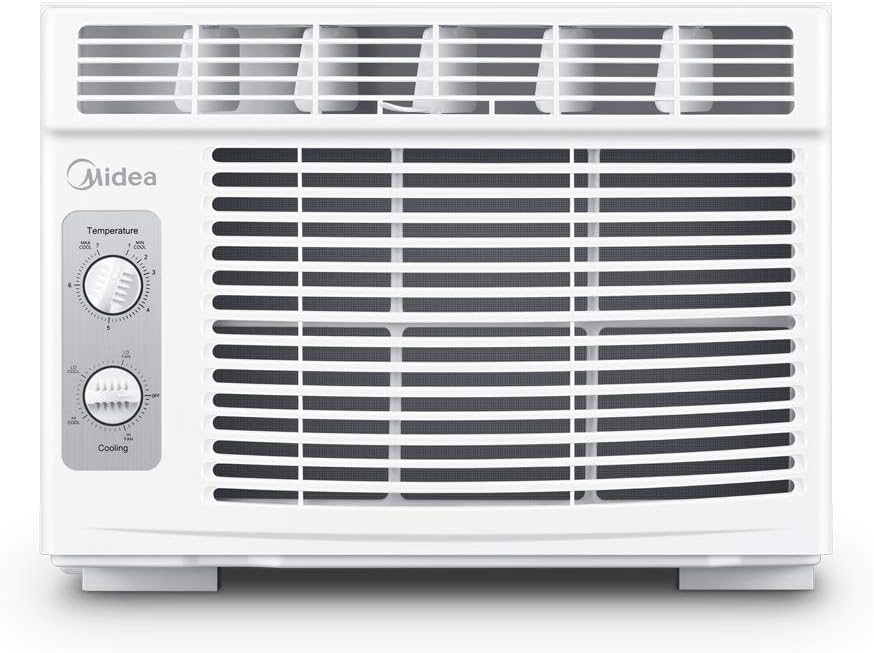
Weight:
- 5,000 BTU: 41.9 pounds
- 12,000 BTU: 74.8 pounds
- The reusable and washable mesh filter reduces room odors
Why we love it:
The Midea MAW10R1BWT offers two versions to cater different camping needs: a 5,000 BTU model available for $179 and a 12,000 BTU model offered at $429. Both versions are highly affordable, given the cooling capacity that they provide.
If you need a powerful and reliable pop-up camper air conditioner, but your camper cannot bear the weight of a comparable rooftop unit without additional structural support, then the 12,000 BTU MAW10R1BWT would be a smart investment. No substantial modifications to the window frames are needed, so installation is a breeze with all the accompanying mounting accessories.
For such an affordable price, you not only get decent cooling capacity but also easy temperature control and many settings to suit varying camping environments: there are 7 temperature settings, 2 cooling/2 fan only speeds and 2-way air direction. The 12,000 BTU model also offers three modes: cooling, air circulation and dehumidifying so you can easily maintain a comfortable living space. The MAW10R1BWT also has a sleep mode that automatically regulates the temperature at night to maintain an ideal temperature during your sleep cycle while saving energy.
The environmentally conscious campers often praise the handy EcoSave function that shuts off the unit once the interior temperature reaches the preset level, allowing this model to achieve a stellar Combined Energy Efficiency Rate (CEER) of 11.0. No matter which mode it is in, this window mounted Midea AC operates at a very low noise level.
Last but not least, this Midea model is backed by a 1-year part and labor warranty, so if yours fails within the warranty period due to manufacturing defects, you are entitled to a free replacement.
4. Arctic King WWK05CM91N

- BTU rating: 5,000 BTU
- Weight: 39.5 pounds
Why we love it:
If you travel in milder climates and don’t need an extra powerful AC, then the compact, lightweight and affordable Arctic King WWK05CM91N is an excellent option. Rated at 5,000 BTUs, it is well suited for smaller pop-up campers and can efficiently cool spaces of up to 150 square feet.
While noise is a concern when you’re sleeping in a small camper, rest assured since the Arctic King WWK05CM91N is very quiet. This model comes with various temperature settings to allow for precise temperature control via a mechanical control dial. It is minimal and basic, but is user friendly and gets the job done, all at a reasonable price loved by budget-minded campers.
This window mounted AC from Arctic King comes with all the necessary mounting accessories and a detailed manual, so most buyers are able to set it up by themselves. A tip shared by many reviewers is that you should make pilot holes on the window frames beforehand to allow the mounting screws to go in smoothly.
One handy feature that you will love is the auto-restart function. If power is cut, then once power resumes, this AC would automatically go back to work under the previous settings.
Best Portable AC For Pop-Up Campers
There are so many models of portable pop-up camper air conditioner out there, but we’ve pick out the one with the most perfect balance of everything: a decent cooling capacity that’s sufficient for various camping environments, reliable performance, long service life, a sleek and compact profile that does not take up a lot of floor space, and affordability.
5. Black + Decker BPACT10WT

- BTU rating: 10,000 BTU
- Weight:
5,500 BTU DOE: 52.9 pounds
6,000 BTU SACC/CEC: 54.8 pounds
Why we love it:
It’s worth noting that you will see two versions available for the Black + Decker BPACT10WT: the 5,500 BTU DOE model and the 6,000 BTU SACC/CEC model, both having the same 10,000 BTU ASHRAE. For the sake of simplicity, just know that this model from Black + Decker delivers a cooling capacity of 10,000 BTU. The ASHRAE reflects the old testing standards used for window mounted units, while the DOE reflects new testing methods developed just for portable ACs. The SACC number simply provides additional information to better reflect the energy efficiency.
Despite not having the highest cooling capacity on the market, this Black + Decker BPACT10WT boasts a BTU rating of 10,000, which is capable of providing fast, effective cooling for spaces up to 250 square feet, pretty impressive for a portable unit. At the coolest setting, it can cool the air to 64°F. And this model is often praised for reliable, steady and uninterrupted cooling at that, thanks to its constant output of powerful airflows through vertical motion.
Another characteristic that makes this model stand out is its user friendliness and adaptability to cater for different needs and camping environments. The full-function remote, coupled with the LED displays, allows for easy customization and precise control.
Sleep mode makes it extra quiet while you rest, while the three modes–cooling, dehumidification and fan– allow you to maintain a comfortable interior living space while maximizing energy efficiency. The dehumidification mode runs on a fuss free bucket-less, self-evaporating operation, ensuring your camper is always dry and clean. Another plus on greenness is that this Black + Decker uses the more environmentally friendly R410a refrigerant.
For easier maintenance, this portable pop-up camper air conditioner comes with slide-out air filters that you can conveniently rinse under a faucet without having to swap in a new one. All in all, for such a compact, versatile and sleek looking AC, you’re getting fantastic cooling capacity, energy efficiency, and easy temperature control without demanding maintenance, all without breaking the bank. For such a well-rounded performance, this model deserves to be praised as the best portable pop-up camper air conditioner that will suit the needs of most camping settings.
Choosing The Best Pop-Up Camper Air Conditioner: Buying Criteria
Cooling Capacity (BTU Rating) and Price
BTU stands for “British Thermal Units” and measures the cooling capacity of an AC unit. The higher the BTU rating of a model, the stronger it is, that is the unit would be able to cool a larger space in a shorter time. And understandably, BTU rating usually is proportional to a particular models’ price, so if price is your concern, you might need to trade off or find a good balance between the two criteria.
Being the most expensive type of pop-up camper air conditioner, rooftop-mounted models cost from $650 to $1,500, the majority of which rated for 13,500 to 15,000 BTUs. The best of the type offer fast and even cooling, as well as easy temperature control with the use of a thermostat.
Meanwhile, window-mounted ACs range from $200 to $500, most of which are rated for as low as 5,000 BTUs and as high as 10,000 BTUs. The portable type has become quite comparable with the window-mounted type regarding price and cooling capacity.
Portable pop-up camper air conditioners range between $250 and $450. Models of the type are rated for as low as 5,000 BTUs, with the most expensive models often rated for 10,000 to 13,000 BTUs. You might find a very few models rated for 15,000 BTUs, but some buyers commented that their cooling capacity is not quite the same as the best roof-top models on the market with the same BTU rating.
You might be surprised to find so many portable ACs with such powerful cooling capacity, with a few models even surpassing the most powerful window-mounted models. This might be somewhat attributed to the fact that these portable pop-up camper air conditioner units also cater for various uses elsewhere, for instance in the home or in the office, and the increasing demand for them thanks to their versatility.
Size/Obtrusiveness
Floor space inside an RV is as valuable as gold, especially in the case of the usually smaller pop-up camper. Notwithstanding their other pros and cons, note that portable units do take up such valuable space, and the more powerful a model is, usually the bigger it will be. Meanwhile, the rooftop and window mounted types are unobtrusive.
Noise
Noise from the cooling/heating system might not be a huge concern if you’re traveling in a big luxury RV, but in a pop-up camper, you will be sleeping pretty close to your RV air conditioner. For the light sleepers, take this into account: portable units are the loudest, while rooftop and window mounted units are quiet. Find yourself a quiet RV air conditioner for better camping experience.
Cost: Acquisition, Installation and Maintenance
In addition to balancing between cooling capacity and price, remember to take installation cost (or difficulty level if you’re DIY) and maintenance or repair costs into account. At one end of the spectrum are portable AC units, which are the cheapest to buy and repair, and also require no installation.
At the other end is the rooftop mounted type: they cost the most, are most expensive to repair and least straightforward to install, which might require professional service (not to mention they might require additional roof support in some cases, which adds to the installation cost). Meanwhile, window mounted air conditioners fall into the middle of the cost spectrum.
The bottom line is, if your top priority is cooling capacity and you have the money to spare, to for a permanently installed rooftop unit. Meanwhile, if you’re considering between window mounted and portable units, remember that nowadays, the average price as well as the average BTU rating of portable units have become quite comparable with the window mounted type, although early portable units used to pale in comparison when it comes to cooling capacity. This means you can find an equally powerful portable AC unit at the same price, but without the nuisance of installation and the resulting cost.
How To Install A Pop-Up Camper Air Conditioner
As instructions might vary between models, make sure you religiously follow the owner’s manual of your chosen model. If you’re lucky, you might also be able to find detailed video tutorials online by a buyer of the exact same model. That said, the general steps to install a pop-up camper air conditioner is as follows:
Step 1: Safety and preparations
Whenever you want to install anything electrical to your rig, always remember to cut the power supply and disconnect the battery as the first safety preparation. Then you can unpack your AC unit.
Unless what you get is a compact and lightweight portable unit, you would most likely need another person to help you lift it out of the box and lay it on the ground on top of some cloth or carton boxes. Then be careful when handling the delicate accessories and components like tubes, connectors, and wirings. Damaging them might cause malfunctions of the air conditioner later on.
Step 2: Drill A Hole in the Camper For Mounting
Some pop-up campers come with pre-drilled holes on the roof as provisions for later installation of air conditioners. In most cases though, you need to drill a hole yourself for mounting the AC. To preserve the integrity of the camper, you must analyze the composition of the exterior before powering up your drill.
For your own safety and drilling precision, make sure your camper is parked leveled on the ground to avoid any unwanted shaking or movements. Carefully measure the AC unit and determine the exact slot you want to mount it, then mark on the window frame or roof the spot to be drilled.
Step 3: Mount The Air Conditioner Unit
It’s best to have an assistant during the mounting process as you’re fitting the unit as well as the associated components into the drilled hole. Remember to lift and lay the unit down gently without dragging it on the floor, or you’ll risk damaging the bottom part of the unit.
Place the AC so that its cords fall inside your camper, then gently wiggle the unit to bring it to the desired position. Then fix the air distribution box. Once everything is in place and secured, connect the power cord to the central connector.
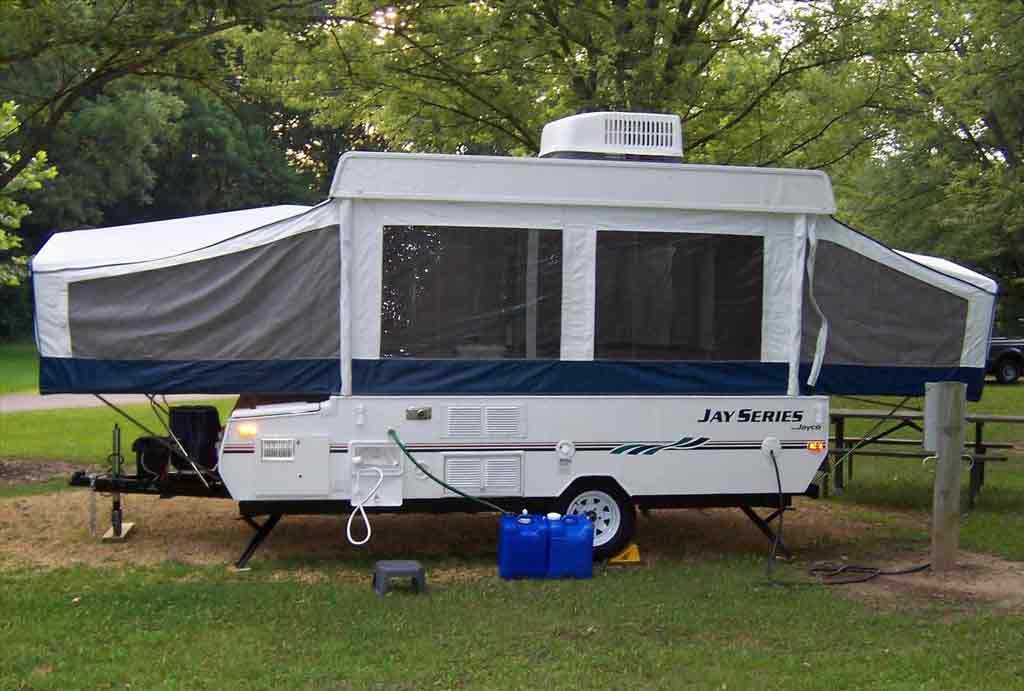
Step 4: Connect The Wirings
Connecting the different components of the unit with corresponding wires is where it’s easy to mess up the different wirings, so follow the manual religiously. Remember not to leave the wires too stretched, or else they would disconnect soon enough.
Once you’ve connected all the required components, make sure to cover all of the wirings in insulation tapes or electrical tapes to avoid the transfer of any electrical current to other components or absent minded hands.
Step 5: Reconnect The Power Supply and Test Run
Given that you’ve done the wirings correctly, it’s still recommended that as a safety measure, you should inspect the wirings, connectors and sockets again to detect any signs of damage and to double check. Then, the only thing left to do is to reconnect the battery of your camper and turn on the power supply. Just hit the circuit breaker and test if you’re getting the long awaited blast of cool air.
How to Maintain Your AC Unit?
- Do not make your AC overwork: During those hot days, you might be tempted to leave your pop-up camper air conditioner on all the time, but this is never good for any kind of machinery. On top of other maintenance tips, one way to prolong the service life of your camper AC is to never let it overwork, or in other words, try all possible measures to keep the inside of your camper as cool as possible to lighten the AC’s load. Easy methods include:
- Always try to park your camper in the shade.
- Find ways to better insulate your canvas-sided camper to keep the hot air out during the hottest hours of the day.
- Also get a compact, portable fan to improve air circulation. Once the outside temperature drops, you can let the fan work to chase out the hotter air inside your camper and let the cooler air outside in. This way, you might be able to reduce the time you turn on the AC.
- Change the air filters: This is the most important task of maintaining your pop-up camper air conditioner. The filters inside air conditioners would accumulate dust and other contaminants in the air over time, thus obstructing air flows. To make sure that your AC unit always operates at peak performance as well as lasts as long as possible, you need to perform periodical inspection and change the air filters from time to time. This is very easy to do, and there are plenty of videos online to guide you through the process.
- Regular maintenance: On top of changing the air filter, your pop-up camper air conditioner also needs other maintenance jobs performed to stay in tip top shape. You might need a HVAC contractor to do the job.
- Always try to park your camper on level ground, which is best for your AC unit.
FAQs about Pop Up Camper AC Units
1. Do pop-up campers have AC or heaters?
Since pop-up campers cater for the minimalist, outdoorsy or budget campers who prioritize flexibility over comfort, they usually don’t come equipped with AC or heaters.
2. Which type of AC is best for pop-up campers?
There are three types of pop-up camper air conditioner: rooftop mounted, window mounted and portable units. Which type is best for you depends on your budget, how often you drive from one place to another and whether you prioritize fast, efficient cooling.
In short, if you often travel in very hot and humid weather and given that budget is not your concern, a rooftop-mounted unit might be the best choice for you: they are powerful, thus can cool a wide area fast. And if you usually hit the road often to hop from one place to another, they are ideal as you won’t need to remove them before hitting the road again. Their disadvantages are that they are heavy, harder to install, and most expensive to buy and repair.
If you travel in milder climates and only have a small pop-up camper to cool and/or you’re a budget traveler, then a portable model would be the cheapest and most energy efficient. They are small and portable, so you can place them anywhere in the camper to quickly cool you down and you can also use them elsewhere in the off-season. The downside is they take up a lot of valuable space inside your already small pop-up camper.
Or if you need something in between the rooftop type and the portable type in terms of cooling capacity and cost, consider window-mounted models. They are more powerful than the portable type but take up no extra interior space. They are cheaper and easier to install than the rooftop type, but you need to remove them everytime you hit the road, so they would be more suitable for campers who stay in one place for an extended period.
3. What size of AC do you need in a pop-up camper?
In general, the bigger your camper is, the higher BTUs you would need so that your air conditioner can effectively cool down your living space. The rule of thumb is that to estimate the recommended BTUs that your AC must be rated for, you need to multiply the total square feet area by 20.
For example, your pop-up camper is 20 feet x 50 ft, equaling 1,000 square feet. Multiply 1,000 with 20 we get 20,000. So you would need a 18,000 BTU RV air conditioner for effective cooling capacity.
4. How much is an air conditioner for a pop-up camper?
Prices vary greatly from $200 up to $1,500 among the rooftop, window-mounted and portable types, and it depends on the BTU rating as well.
The portable pop-up camper air conditioner ranges between $250 and $450. Models of the type are rated for as low as 5,000 BTUs, with the most expensive models often rated for 10,000 to 13,000 BTUs. You might find a very few models rated for 15,000 BTUs, but some buyers commented that their cooling capacity is not quite the same as the best roof-top models on the market with the same BTU rating.
Being the most expensive type of pop-up camper air conditioner, rooftop-mounted models cost from $650 to $1,500, the majority of which rated for 13,500 to 15,000 BTUs. The best of the type offer fast and even cooling, as well as easy temperature control with the use of a thermostat.
Window-mounted ACs range from $200 to $500, most of which are rated for as low as 5,000 BTUs and as high as 10,000 BTUs.
